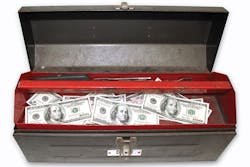Making Equipment Investments to Keep Your Doors Open
Consolidation in the collision repair industry has been a common theme recently. Large multi-shop operators have been buying up independent shops across the country left and right.
Nick Notte, president of Sterling Autobody Centers, says this is a trend that peaked in 2010. In 2009, with the economy tanking, Notte expected that to be an ideal time to make offers on struggling businesses. Not quite. “We found it was very difficult to pry these businesses away from the owners. But 2010 was the complete opposite; these owners couldn’t give us their businesses fast enough.”
What gives? Auto manufacturers have been rapidly changing their vehicle designs and required repair procedures. Many shops need equipment upgrades to accommodate those changes, and some are unwilling—or unable—to put out the necessary cash for that.
“There is a renewed investment required in the industry right now,” says Steve Trapp, collision services development manager for DuPont Performance Coatings. “New vehicle construction techniques and materials used by auto manufacturers have caused an additional investment for shops.”
And the equipment upgrades aren’t exactly cheap. The number of repair facilities in the U.S. has decreased over the last three years from about 43,000 down to 39,000, according to The Romans Group. Trapp says a shrinking and shifting market is the major cause, but during tough economic times the equipment investment requirements may also be contributing to some of the closures.
Equipment Expense
Sterling scoured the country for new acquisition opportunities throughout 2010. Right now, the company has 30 possibilities in the pipeline, Notte says, none of which are operated by people who are willing to invest the money necessary to move forward.
Dave Gruskos, president of Fair Haven, N.J.–based Reliable Automotive Equipment Inc., provides shops with the equipment needed to repair vehicles with new high-strength materials. Between the new welding equipment, riveting equipment and adaptations to a shop’s existing frame machine, shop operators could be spending as much as $100,000, he says. And that cost could be doubled if the shop operator is looking to attain a particular OEM certification.
Gruskos says the high cost of these investments is one of the main reasons he sees shop owners opt to get out of the business.
“It’s becoming much more prevalent now than ever because of the hurdles shop owners have to jump to get financing these days,” Gruskos says. “They’re no longer able to get the lines of credit and financing needed to stay in business.”
Notte agrees: Today’s costs are affecting some long-time shop operators, he says. “I’ve been amazed this year to see how many shop owners are unable to meet the challenges of equipment, training and tooling costs.”
Close or Diversify
Now is clearly not an ideal time for shop operators to sell their business given the current economic climate. The ones who are selling are doing so for bargain prices. This has caused some shop owners to make alternative decisions. Some have diversified their business model, and surprisingly, some have just locked the doors and walked away.
“It’s amazing that instead of trying to sell their business, shop owners seem to be just closing their doors,” Notte says, noting he’s seen this phenomenon across the country. In fact, of the 30 facilities Sterling is looking to acquire, 10 of them have done exactly that.
Still, Trapp says diversification has been the answer for some shop owners who aren’t interested in spending six figures to upgrade their equipment. “They can use the same facility and tools to run other types of businesses.”
Rather than closing, some branch out into restoration or mechanical work, Trapp says. He adds that shops in this situation might still choose to offer collision services, but they may further diversify by also offering cosmetic repairs.
Market Your Investment
If you weather the storm and invest in new equipment—rather than jump ship—remember to market your investments to dealerships and potential customers in your area. This is especially important if your shop attains an OEM certification, Trapp says.
“Some shop owners are equipment junkies. They enjoy buying new equipment to make their repair centers more efficient,” Trapp says. The problem, he adds, is that some shop operators will buy the new equipment, but neglect to inform consumers and others that the repair center is now equipped and qualified to repair modern vehicles. “When they don’t market the benefits, that equipment investment just makes them that much less financially stable, instead of attaining the desired improvement the equipment ought to provide.”
